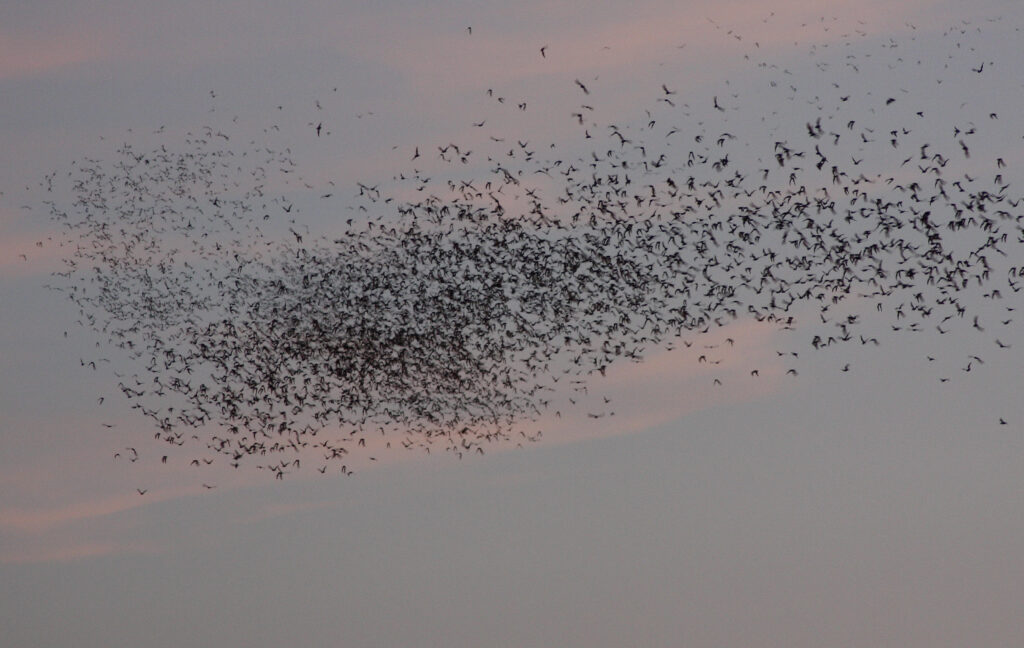There’s something thrilling about being in the presence of wildlife in huge numbers. A colony of about 250,000 Mexican free-tailed bats call narrow crevices under the Yolo causeway home. To watch clouds of bats fly from their roost at dusk to forage for insects, attend Yolo Basin Foundation’s “Bat Talk and Tour” event. It’s not to be missed. The causeway colony of free-tailed bats might be the largest colony of bats in California. After overwintering in southern California or possibly Mexico, the bats return to the Bypass around March. Starting in late June, females give birth to a single pup. Every night, nursing females leave to eat almost their own weight in moths, beetles, midges, mosquitos, stinkbugs, and other insects using echolocation with high-frequency sounds produced by their larynx. Mother bats reunite with their young by vocalizations and scent. In mid-fall most of the bats head south. They will return to the same roost year after year.  Superlatives come easily for Mexican free-tailed bats. It has been claimed that they have the fastest horizontal speed of any animal, reaching top ground speeds near 100 mph (https://doi.org/10.1098/rsos.160398)! They also fly at altitudes of nearly 11,000 feet, among the highest of all bats, to catch moths. And they are regarded as one of the most abundant mammals in North America. Very large colonies are the norm. Up to 1.5 million bats roost under the Congress Avenue Bridge in Austin, Texas. The largest known colony is in the Bracken Cave, near San Antonio, Texas, with nearly 20 million bats. The Mexican free-tailed bat ranges from the southern U.S. into South America. Until DNA-based methodologies became commonplace, it was long thought there were two main groups of bats. One consisted of the fruit-eating bats, called megabats (although not all are large as the name implies), which don’t echolocate. Megabats include bats like flying foxes with large eyes and an excellent sense of smell. The second group consisted of smaller bats, called microbats, that mostly eat insects they catch on the wing using echolocation. The Mexican free-tailed bat is an example of a microbat. This taxonomic grouping turned out to be incorrect. Genetic evidence in the 2000s clearly showed that some echolocating microbats share a common ancestor with the megabats. As a result, two new groups of bats, Yinpterochiroptera, or the Yin, and Yangochiroptera, or the Yang, were proposed. The megabats and old-world echolocating horseshoe bats, leaf-nosed bats, and a few other microbat species form the Yin group. The Yang group consists of 82% of all echolocating bat species and most microbat families. They are ecologically the most varied and diverse bat group. Most Yang species are insectivorous, but ecological niches and prey preferences vary. Some catch and feed on vertebrates like birds, frogs, and other bats, and some are frugivores (fruit eating). Despite the clear genetic signal of the Yin and the Yang, there was no known anatomical trait that confirmed the new taxonomic scheme, which was based solely on DNA evidence. What physical feature could possibly unite a large, non-echolocating, sight-oriented flying fox with a small bat that hunts insects by echolocation? And what would unite the almost 900 species of the Yang bats? A recent discovery revealed that the anatomy of the inner ear was the key. The inner ear of bats consists of the snail-shaped cochlea lined with sensory hairs cells, which convert vibrations into neural signals. These signals are carried from the ear to the brain by neurons, which in most mammals are surrounded by a bony tube, called the Rosenthal’s canal. This is where the surprising difference between the Yin and the Yang was discovered (Sulser, R., et al. 2022. Nature 602:449-454). The Yin bats, like other mammals (except the echidna and platypus, which are special exceptions), have a Rosenthal’s canal completely covered in bone. But in Yang bats the canal is wall-less. This means there is a larger space for neurons to vary in size, number, and complexity, opening the door for the evolution of greater processing of sound waves and diverse forms of echolocation. It is possible that variations in the canal of Yang bats correspond in some way to the large number of species of Yang bats and their extreme diversity of ecological specializations in behavior, habitats, and diets. Now we know that Yin and Yang bats are separated not by behavior, ecological niche, or feeding preference, but by their evolutionary history, which is supported by the differences in the anatomy of their inner ears. Since the Yin group of bats consists of both echolocating and non-echolocating bats, did echolocating evolve once in the ancestor to all bats, with a subsequent loss in the megabats, or did it evolve twice, once in the Yin and once in the Yang? The question is not fully resolved but one interpretation is that the ancestor to all bats had laryngeal echolocation which was subsequently lost in fruit-eating megabats. The large eyes of flying foxes and relatives likely evolved after the degeneration of echolocation. There is a megabat in the genus Rousettus that uses tongue-clicking to echolocate in caves, but that is unique and evolved independently. Interestingly, porpoises and toothed whales also click to echolocate but in a different manner. They produce clicks by moving air between sinuses in the head. Echolocation has evolved in other groups of animals as well, including oilbirds, swiftlets, dormice, tenrecs, and shrews. Dark caves, underground tunnels, moonless nights, muddy waters, and deep oceans have all been brought into the light! Want to learn more about these amazing mammals and see the largest urban colony in California for yourself? Sign up for Yolo Basin Foundation’s Bat Talk and Tour or one of our special events. |
| Photo credits: Mike Davis |




